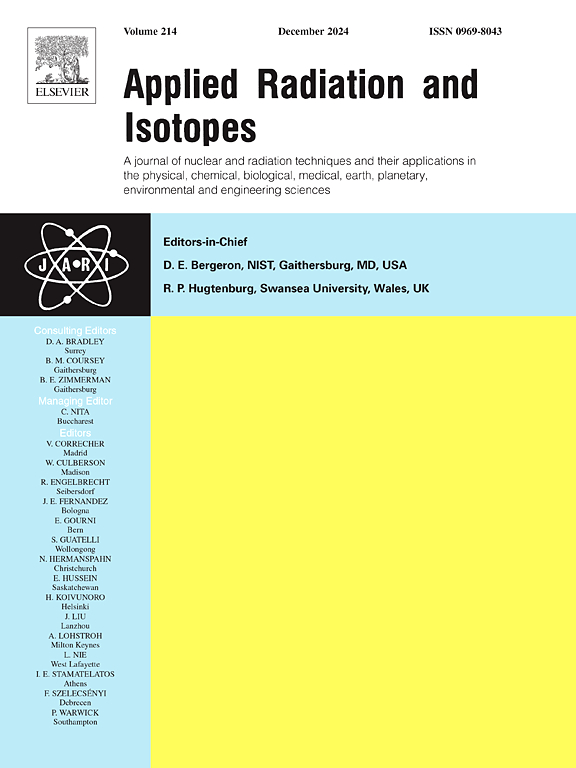纯铝硼酸镁和掺杂铈的铝硼酸镁玻璃的结构、振动和发光特性
IF 1.6
3区 工程技术
Q3 CHEMISTRY, INORGANIC & NUCLEAR
引用次数: 0
摘要
这项工作的目的是研究用熔淬法生产的纯硼铝镁锂(BAlMgLi)和掺杂铈的硼铝镁锂(BAlMgLi)新玻璃体样品的特性。采用 X 射线衍射 (XRD)、振动拉曼光谱和振动傅立叶变换红外光谱 (FTIR) 分析了样品的结构和振动特性。此外,还使用了光激发发光(OSL)和热发光(TL)技术来确定样品是否对电离辐射有反应。XRD 分析证实了样品以无定形相为主。拉曼光谱显示,材料基体中的原子键属于焦硼酸盐和偏硼酸盐类型,可在孤立的 BO4 和/或 Al-O 或 Al-O-B 单元中产生伸缩振动。约 810 cm-1 处的波段是硼氧醇环形成的特征,表明基体中其他元素的存在不会影响其玻璃特性。傅立叶变换红外光谱分析证实了拉曼光谱的结果,因为观察到了低吸湿性玻璃的特征谱带,这是由于在三硼酸盐、四硼酸盐和五硼酸盐基团中,BO3 单元转化成了 BO4。这种转化是由于掺杂夹带造成的,这也是样品具有高光学透明度的原因之一。这些样品的 OSL 和 TL 信号具有可重复性,其强度取决于掺杂剂浓度和辐射剂量,其中 0.5% Ce 浓度的样品辐射最强。本文章由计算机程序翻译,如有差异,请以英文原文为准。
Structural, vibrational, and luminescent properties of pure and Ce-doped magnesium lithium aluminoborate glass
The objective of this work was to study the properties of new vitreous samples of pure BAlMgLi and Ce-doped BAlMgLi produced by the melt-quenching method. The structural and vibrational characteristics of the samples were analyzed using x-ray diffraction (XRD), vibrational Raman spectroscopy, and vibrational Fourier transform infrared spectroscopy (FTIR). Optically stimulated luminescence (OSL) and thermoluminescence (TL) techniques were also used to identify whether the samples showed a response to ionizing radiation. XRD analyses confirmed the predominance of the amorphous phase of the samples. The Raman spectra revealed that the atomic bonds present in the material matrix are of the pyroborate and metaborate type, enabling stretching vibrations in isolated BO4 and/or Al–O or Al–O–B units. The band at approximately 810 cm−1 is characteristic of the formation of the boroxol ring, indicating that the presence of other elements in the matrix does not affect its glassy characteristics. The FTIR analyses reinforce the results found by Raman spectroscopy, because bands characteristic of low hygroscopic glasses were observed, due to the conversion of BO3 units into BO4 in triborate, tetraborate, and pentaborate groups. This conversion is due to dopant entrainment, which contributes to the high optical transparency of the samples. Their OSL and TL signals were reproducible with intensities dependent on the dopant concentration and radiation dose, with the most intense emissions resulting from 0.5% Ce concentrations.
求助全文
通过发布文献求助,成功后即可免费获取论文全文。
去求助
来源期刊

Applied Radiation and Isotopes
工程技术-核科学技术
CiteScore
3.00
自引率
12.50%
发文量
406
审稿时长
13.5 months
期刊介绍:
Applied Radiation and Isotopes provides a high quality medium for the publication of substantial, original and scientific and technological papers on the development and peaceful application of nuclear, radiation and radionuclide techniques in chemistry, physics, biochemistry, biology, medicine, security, engineering and in the earth, planetary and environmental sciences, all including dosimetry. Nuclear techniques are defined in the broadest sense and both experimental and theoretical papers are welcome. They include the development and use of α- and β-particles, X-rays and γ-rays, neutrons and other nuclear particles and radiations from all sources, including radionuclides, synchrotron sources, cyclotrons and reactors and from the natural environment.
The journal aims to publish papers with significance to an international audience, containing substantial novelty and scientific impact. The Editors reserve the rights to reject, with or without external review, papers that do not meet these criteria.
Papers dealing with radiation processing, i.e., where radiation is used to bring about a biological, chemical or physical change in a material, should be directed to our sister journal Radiation Physics and Chemistry.
 求助内容:
求助内容: 应助结果提醒方式:
应助结果提醒方式:


